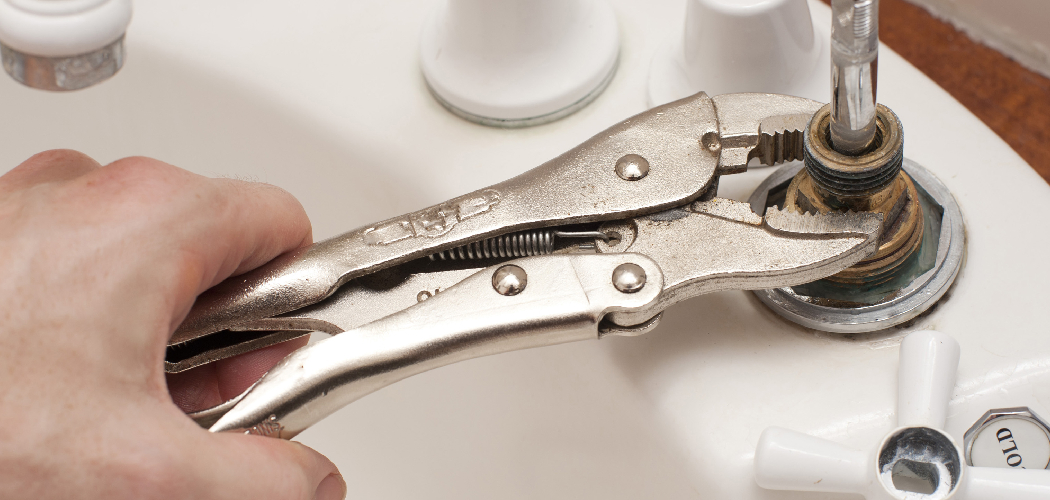Determining whether a faucet cartridge is bad is crucial for maintaining a functional plumbing system and preventing leaks. The cartridge serves as the control mechanism for regulating water flow and temperature in many modern faucets. When it malfunctions or wears out, it can lead to issues such as dripping faucets, inconsistent water pressure, or even complete loss of water flow.
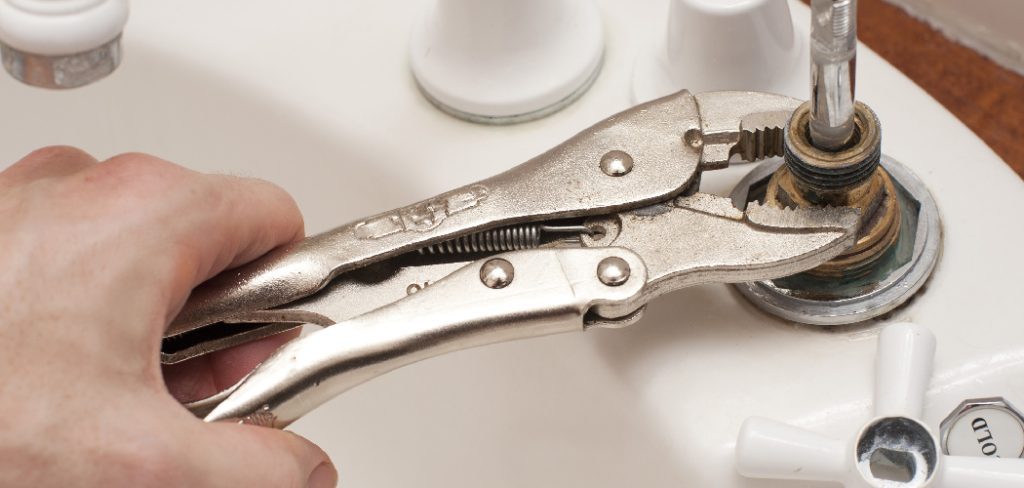
Recognizing the signs of a faulty faucet cartridge is essential for timely intervention and repair. In this guide, we’ll delve into how to tell if faucet cartridge is bad. From unusual noises to visible leaks and difficulty adjusting water temperature, we’ll explore the telltale signs that signal it’s time to inspect and potentially replace your faucet cartridge.
Understanding these signs will empower you to address cartridge issues promptly, ensuring smooth operation and longevity of your plumbing fixtures.
Importance of A Functional Faucet Cartridge
Maintaining a functional faucet cartridge is paramount to ensuring the efficiency and durability of your plumbing system. A well-operating cartridge not only guarantees a smooth and precise control over water flow and temperature but also contributes significantly to water conservation.
An impaired cartridge often leads to leaks and drips, which can result in considerable water wastage over time. Additionally, it can cause unexpected fluctuations in water temperature, posing risks of scalding or uncomfortably cold water. By preventing these issues, a functional cartridge supports a more sustainable and safe household environment.
Furthermore, addressing cartridge problems promptly can save homeowners from costly repairs and replacements in the future, highlighting the importance of regular maintenance and timely intervention.
Common Signs Indicating a Bad Cartridge
Identifying the common signs of a bad faucet cartridge is the first step towards rectifying water flow and pressure issues in your home. Here are several indicators that your faucet cartridge may need attention or replacement:
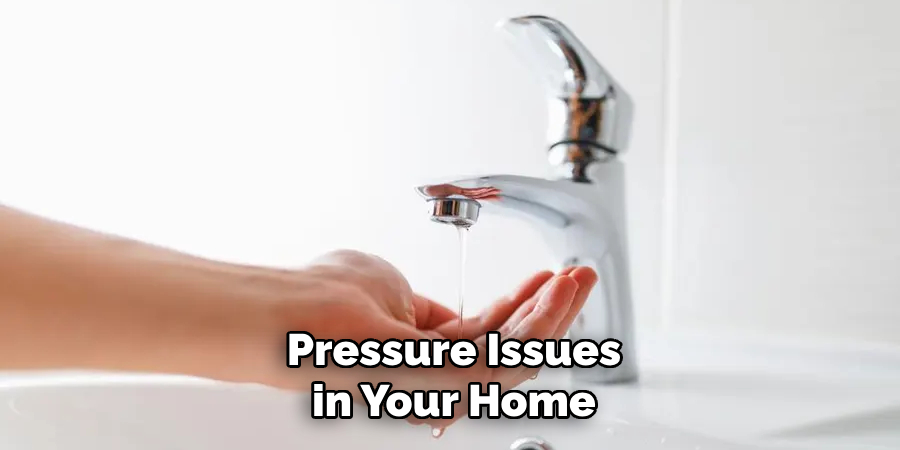
- Leaking Faucet: One of the most apparent signs of a bad cartridge is persistent dripping or leaking from the faucet, even when it’s turned off tightly. This not only wastes water but can also lead to higher utility bills over time.
- Irregular Water Pressure: If you notice sudden changes in water pressure, such as a weak flow or intermittent bursts of strong pressure, the cartridge may be the culprit. This inconsistency can disrupt daily activities like washing dishes or taking showers.
- Difficulty in Adjusting Temperature: A malfunctioning cartridge can make it challenging to adjust the water temperature. You may experience a delay in response or find that turning the handle doesn’t effectively change the water temperature.
- Strange Noises: Unusual sounds coming from the faucet, such as whistling, squeaking, or chattering, can indicate that the cartridge internals are failing. These noises may occur when the faucet is turned on, off, or during operation.
- Hard to Operate Handles: If the faucet handle becomes stiff or difficult to turn, it could signify that the cartridge is starting to seize up. A fully functional cartridge allows for smooth and effortless adjustment.
Addressing these signs promptly by inspecting and possibly replacing the faulty cartridge can prevent further plumbing issues and ensure your faucet operates efficiently.
Importance of Timely Detection and Resolution
The importance of detecting and resolving issues with a bad faucet cartridge cannot be overstated. Timely detection allows homeowners to prevent more significant damage to their plumbing system, which can be both inconvenient and costly to repair. Early resolution of cartridge issues not only restores proper function to faucets, ensuring a steady and predictable flow of water, but it also mitigates the risk of water damage to surrounding areas.
Persistent leaks or drips can lead to water stains, corrosion, and even mold growth over time, posing health risks and potentially compromising the structural integrity of countertops, cabinets, and fixtures.
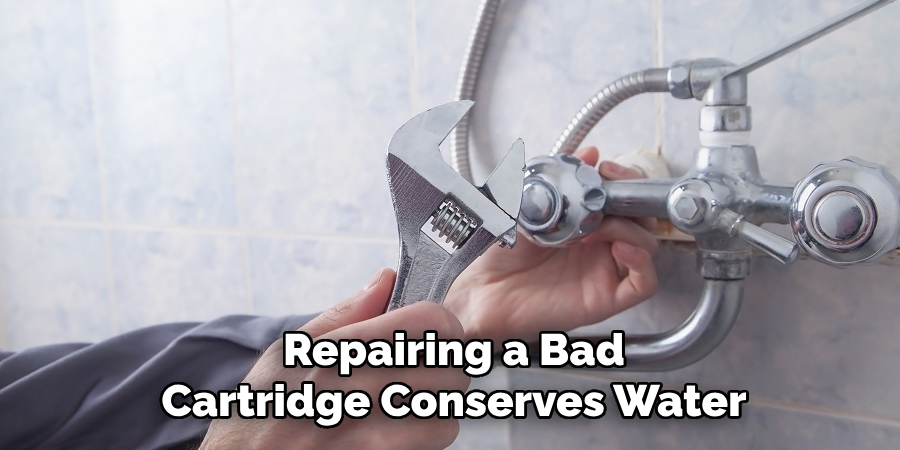
Furthermore, quick action in replacing or repairing a bad cartridge conserves water, aligning with environmental sustainability efforts and saving on utility expenses. By understanding the critical signs and acting promptly, homeowners can maintain the performance and longevity of their plumbing systems while ensuring a safe, comfortable, and efficient living environment.
Understanding the Role of the Faucet Cartridge
The faucet cartridge is an essential component of modern plumbing systems, acting as the heart of the faucet. Positioned within the faucet’s body, it regulates both the volume of water flow and the temperature mix by controlling the movement of water through the faucet.
Essentially, it works by adjusting the openings through which hot and cold water can pass, based on the handle’s position. The design of the cartridge allows for precise control, ensuring users can easily manage the flow and temperature to their preference.
Cartridges come in various types and configurations, tailored to different kinds of faucets and user needs. Some are simple, designed for faucets with a single handle that controls both temperature and flow, while others are more complex for faucets with separate controls. The durability and functionality of a cartridge depend largely on its material and build quality, which can significantly influence the longevity and reliability of the faucet itself.
Despite its small size, the faucet cartridge plays a pivotal role in ensuring the efficiency, reliability, and usability of the faucet. By facilitating smooth operation and preventing leaks, a well-functioning cartridge not only saves water but also contributes to the overall conservation of resources. This underscores the importance of the cartridge in maintaining an eco-friendly and cost-effective household.
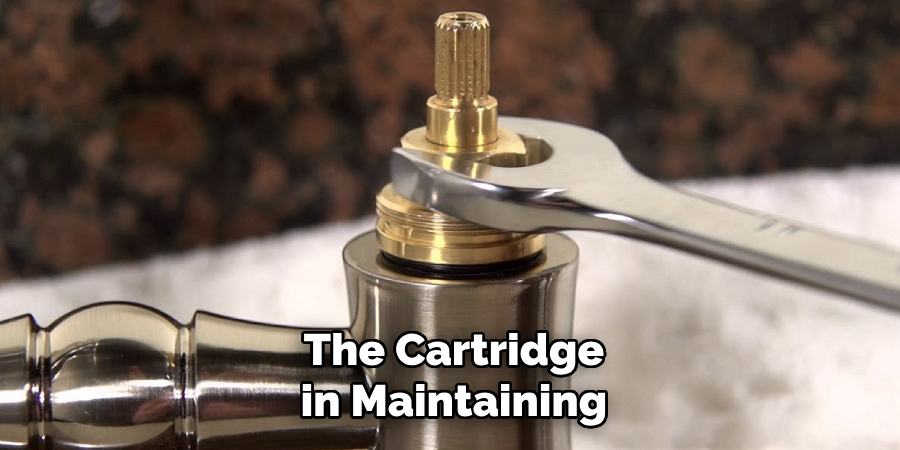
Types of Cartridges and Their Variations
In the realm of plumbing and faucets, understanding the different types of cartridges available is crucial for maintenance, repairs, or when considering upgrades. Each type of cartridge caters to specific faucet designs and functionality, affecting everything from water flow control to how temperature adjustments are made. Here are the predominant types of faucet cartridges and their unique characteristics:
- Compression Cartridges: Often found in traditional two-handle faucets, compression cartridges are one of the oldest types. They work by tightening a screw to compress a washer against a valve seat, controlling the flow of water. These cartridges usually require more strength to turn off completely and are more prone to dripping if the washer wears out.
- Ball Cartridges: Exclusive to single-handle faucets, ball cartridges utilize a ball bearing to control water flow and temperature. The handle movement allows the ball bearing to align with the hot and/or cold water inlets within the faucet body. These cartridges are identifiable by their distinctive ball-shaped construction and offer a wide range of handle motion for precise temperature and flow adjustments.
- Disk Cartridges: Ceramic disk cartridges represent a modern solution, featuring two ceramic disks in a sealed cylinder behaving as the water control gate. One disk is stationary while the other moves with the handle, creating or restricting water flow. These cartridges boast longevity and exceptional resistance to wear and tear, often found in single-handle faucets.
- Sleeve Cartridges: Sleeve cartridges, also known as sleeve-cylinder cartridges, use a cylindrical sleeve controlled by the faucet’s handle to regulate water flow and temperature. They are simpler in design compared to ball or disk cartridges, making them easier to maintain and replace. Sleeve cartridges are commonly used in both single and two-handle faucets, applicable for a variety of design aesthetics and functionalities.
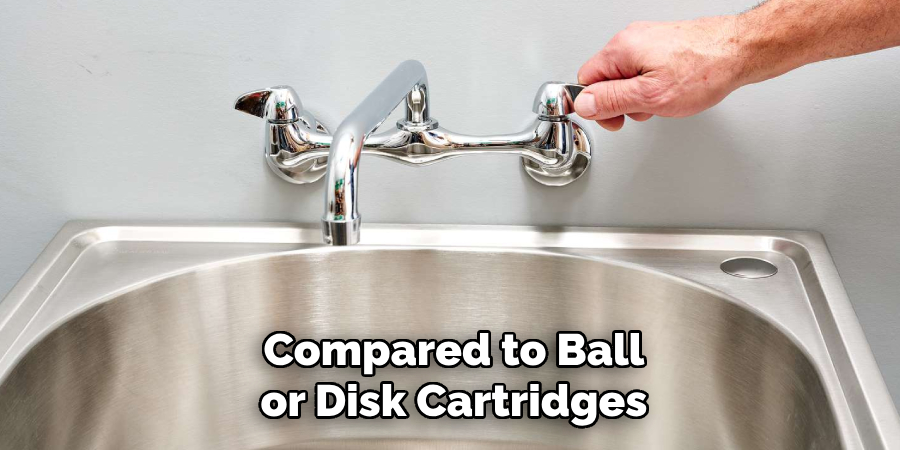
Each cartridge type has its advantages and areas of application. Compression cartridges, with their straightforward design, are often easier and cheaper to repair, typically requiring only a washer replacement. Ball cartridges offer a high level of control in a compact form, making them suitable for kitchens and bathrooms alike.
Ceramic disk cartridges provide a durable, low-maintenance solution, increasingly preferred in contemporary homes for their reliability and smooth operation. Lastly, sleeve cartridges offer a balance between simplicity and effectiveness, often favored for their adaptability and ease of use.
Selecting the right cartridge depends on various factors, including faucet design, preferred handle operation, and maintenance considerations. Understanding the nuances of each type can greatly aid in making informed decisions regarding faucet maintenance or upgrades, ensuring longevity and optimal performance of your plumbing fixtures.
Difficulty in Turning the Faucet Handle
One common issue homeowners may encounter with their plumbing fixtures is difficulty in turning the faucet handle. This problem can manifest as stiffness, resistance, or uneven movement when attempting to adjust water flow or temperature. Several factors contribute to this issue, primarily stemming from the internal components of the faucet, specifically the cartridge.
Wear and tear on the cartridge is a primary cause of a stiff faucet handle. Over time, mineral deposits from hard water can accumulate within the cartridge and on its moving parts, leading to friction and making it harder to turn the handle. Additionally, the rubber O-rings and seals within the cartridge can deteriorate, losing their elasticity and creating additional resistance.
Another contributing factor could be improper installation or alignment of the cartridge. If the cartridge is not seated correctly within the faucet body, or if it has shifted from its original position, it can lead to uneven or difficult handle movement. Similarly, if the handle mechanism itself is damaged or misaligned, this can also result in operational difficulties.
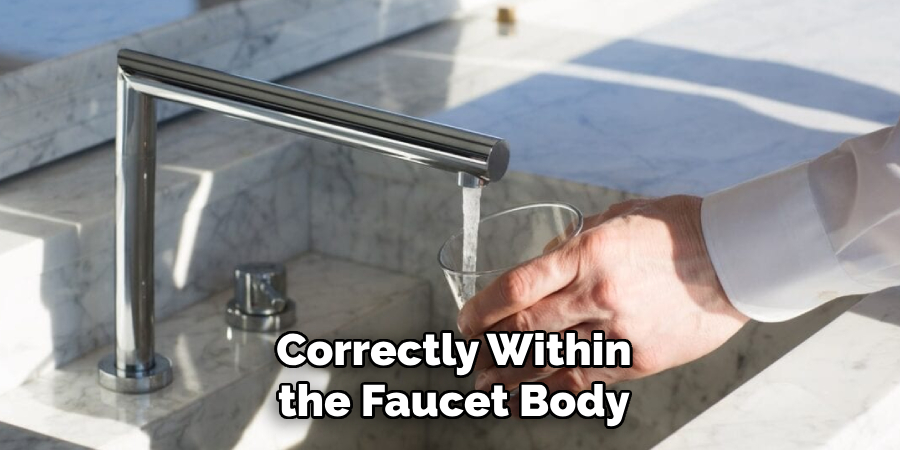
Addressing a stiff faucet handle typically involves inspecting the cartridge for signs of wear, mineral buildup, or damage. In many cases, cleaning the cartridge and replacing any worn parts can restore smooth operation.
However, in instances where the cartridge is significantly damaged or outdated, replacing it with a new one is often the most effective solution. Regular maintenance and periodic checks of the faucet’s internal components can prevent this issue from occurring, ensuring a smooth and effortless experience when using the faucet.
Temperature Control Issues
Aside from the mechanical movements of turning the faucet on and off, temperature control stands as a significant aspect of faucet functionality. Users may encounter issues where the water temperature does not adjust correctly, resulting in water that’s too hot or too cold, despite how the handle is manipulated. This problem often roots back to the internal mechanics of the faucet cartridge.
For instance, in ball cartridges, misalignment or deterioration of the ball bearing can impede its ability to properly mix hot and cold water, leading to temperature inconsistencies. Similarly, with disc cartridges, wear or debris on the ceramic plates might prevent them from sealing correctly, hindering effective temperature regulation.
Temperature control issues can also signal a problem with the faucet’s water supply system. Imbalances in the pressure between hot and cold water lines can affect how water flows through the cartridge, impacting the final temperature output.
To rectify these challenges, homeowners can start by examining the cartridge for any visible damage or misalignment. Cleaning the cartridge to remove mineral deposits or replacing worn-out parts might solve the issue.
However, for persistent temperature control problems, replacing the cartridge or consulting a plumbing professional might be necessary. Proper maintenance and understanding of the faucet’s design will ensure optimal temperature control and contribute to a more pleasant and efficient household water usage experience.
10 Methods How to Tell if Faucet Cartridge Is Bad
1. Leaking Faucet:
Perhaps the most apparent sign of a failing faucet cartridge is a leaking faucet. If you notice water dripping or flowing from the faucet even when it’s turned off, it’s a clear indication that the cartridge may be worn out or damaged. Leaks can occur due to worn seals or cracks within the cartridge, leading to water seepage and potential water wastage.
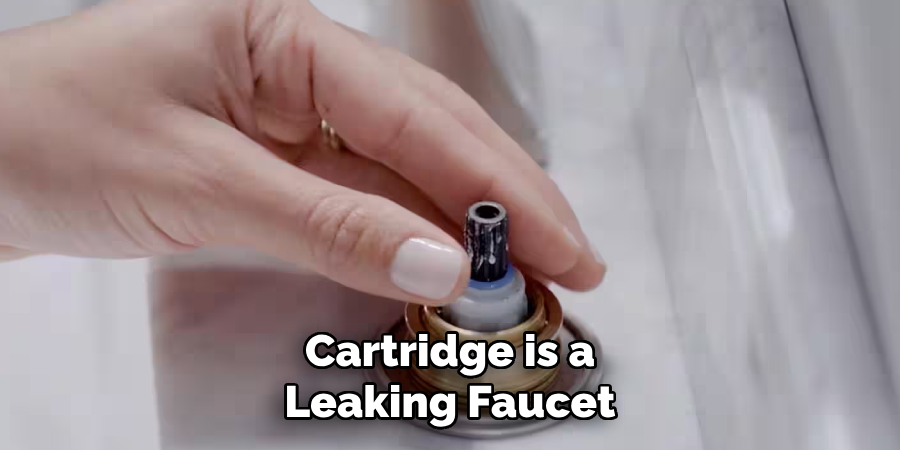
2. Irregular Water Flow:
A malfunctioning faucet cartridge can lead to irregular water flow, causing sudden changes in water pressure or inconsistent flow rates when using the faucet. If you notice fluctuations in water pressure or if the flow is weaker or stronger than usual, it may be a sign that the cartridge is failing to regulate water flow effectively.
3. Difficulty Adjusting Temperature:
Faucet cartridges play a crucial role in controlling water temperature, allowing you to adjust the temperature of the water according to your preferences. If you find it challenging to adjust the temperature of the water coming from your faucet or if the water temperature fluctuates unexpectedly, it could be due to a faulty cartridge.
4. Strange Noises:
Unusual noises emanating from the faucet when you turn it on or off, such as rattling, squeaking, or grinding sounds, could indicate a problem with the cartridge. These noises may be caused by worn-out internal components or loose fittings within the cartridge, affecting its ability to function properly.
5. Stiff or Loose Handle:
A faucet handle that feels stiff, loose, or difficult to turn may be a sign of a failing cartridge. Over time, the internal components of the cartridge can wear out, leading to issues with the handle’s operation. A stiff handle may indicate friction within the cartridge, while a loose handle may suggest internal components are no longer properly engaging.
6. Visible Damage or Corrosion:
Inspect the faucet cartridge for any visible signs of damage, such as cracks, chips, or corrosion. These issues can compromise the cartridge’s integrity and lead to leaks or other performance issues. Corrosion, in particular, can weaken the cartridge’s structure, making it more prone to failure.
7. Persistent Drips After Shutting Off:
Even after turning off the faucet, if you notice that water continues to drip from the spout or handle, it’s a clear indication that the cartridge is not sealing properly. This persistent dripping can result from worn-out seals or damaged components within the cartridge, allowing water to escape despite the faucet being in the closed position.
8. Water Discoloration or Odors:
A failing faucet cartridge can sometimes cause water discoloration or unusual odors. If you notice changes in the color or smell of the water coming from your faucet, it’s worth investigating the cartridge as a potential source of the issue. Contaminants or debris within the cartridge can affect the quality of the water, leading to discoloration or odors.
9. Frequent Repairs:
If you find yourself needing to repair or replace other components of your faucet frequently, such as washers or seals, it could be a sign that the underlying cause of the problem lies with the cartridge. Addressing the cartridge issue may help prevent future repairs and ensure the long-term functionality of your faucet.
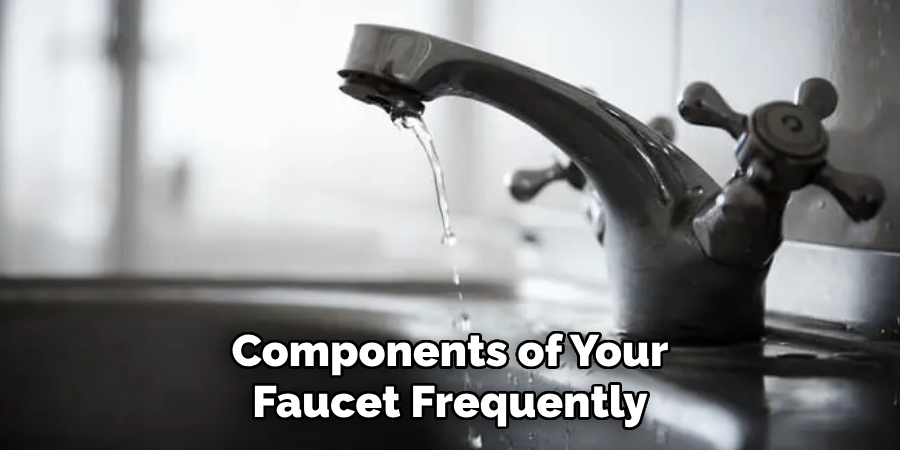
10. Age of the Faucet:
Finally, consider the age of your faucet when assessing the condition of the cartridge. If your faucet is several years old and you’re experiencing any of the aforementioned issues, it’s possible that the cartridge has reached the end of its lifespan and needs to be replaced. Over time, normal wear and tear can degrade the cartridge’s performance, making it more susceptible to failure.
Conclusion
In conclusion, recognizing the signs of a bad faucet cartridge is essential for maintaining a properly functioning plumbing fixture. Whether it’s experiencing persistent leaks, reduced water flow, or difficulty in controlling water temperature, these symptoms can indicate underlying cartridge issues.
By conducting visual inspections, performing tests, and observing consistent symptoms across multiple faucets, you can confirm cartridge problems. Promptly addressing these issues through cartridge replacement, cleaning, or lubrication can restore optimal faucet performance and prevent water waste.
Additionally, implementing preventative measures such as regular cleaning and using water softeners or faucet filters can help extend the lifespan of your cartridge and minimize future problems. Thanks for reading, and we hope this has given you some inspiration on how to tell if faucet cartridge is bad!

